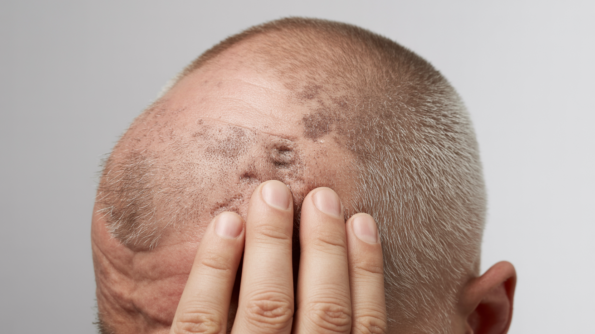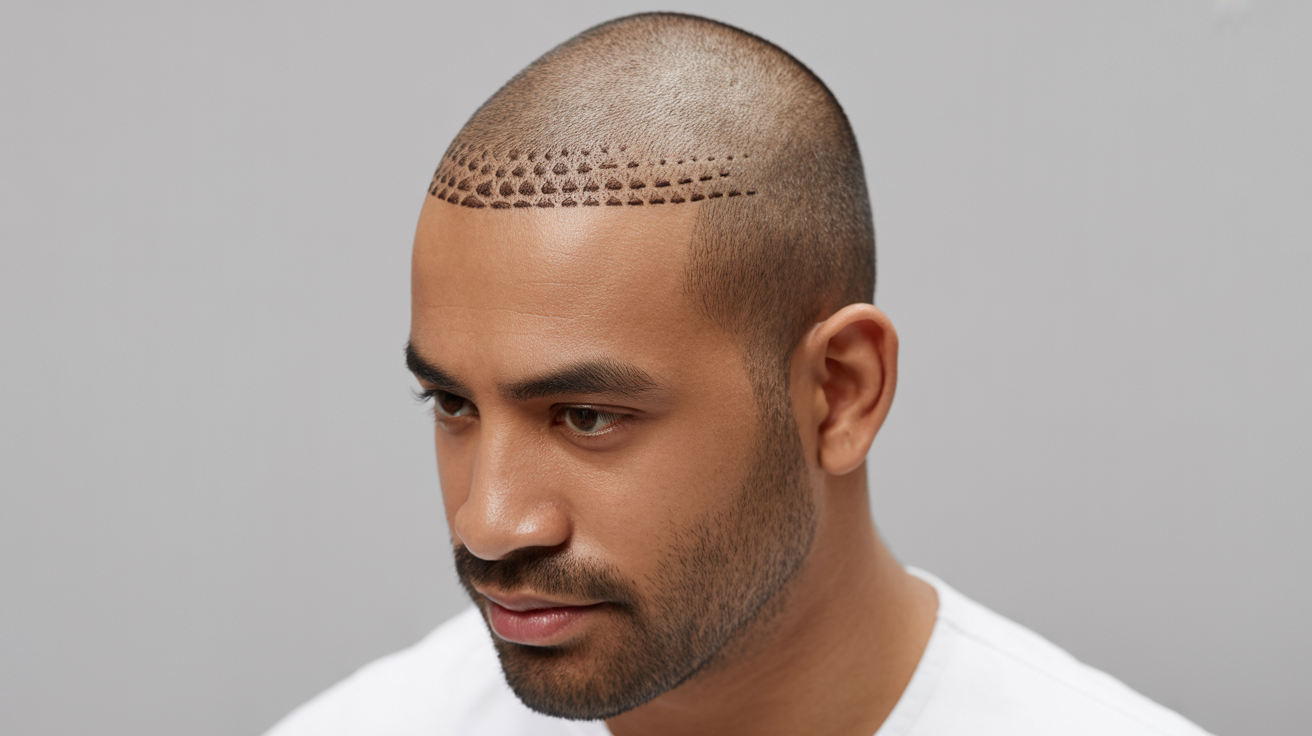Scarring alopecia, also known as cicatricial alopecia, is one of the most challenging types of hair loss. Unlike other forms of alopecia where the follicles remain intact, scarring alopecia destroys hair follicles permanently and replaces them with scar tissue. This means the scalp loses its ability to grow hair naturally in those affected areas.
But does this mean people with scarring alopecia can never restore their hair? Not necessarily. With modern techniques like Follicular Unit Extraction (FUE) and careful medical planning, Hair Transplants for Scarring Alopecia are now possible. However, they are more complex than standard transplants and require special considerations.
In this guide, we’ll cover everything you need to know:
- What scarring alopecia is and why it causes permanent hair loss
- Whether hair transplants work for scarring alopecia patients
- How the transplant process works on scarred tissue
- Who qualifies as a good candidate
- The success rates, limitations, and aftercare tips
- Alternative and supportive treatments for better results
What is Scarring Alopecia?
Scarring alopecia (cicatricial alopecia) is not just one disease but a group of rare conditions that permanently destroy hair follicles. The damage leads to inflammation and scar formation inside the scalp. Once the scar tissue replaces the follicles, the skin in that area cannot naturally regrow hair. Some common causes include:- Lichen planopilaris (LPP)
- Frontal fibrosing alopecia (FFA)
- Central centrifugal cicatricial alopecia (CCCA)
- Trauma or injury (accidents, burns, surgeries, or radiation)
- Tight hairstyles over many years (traction alopecia)
Does Scarring Alopecia Go Away on Its Own?
Unfortunately, scarring alopecia does not reverse naturally. Once follicles are replaced by scar tissue, hair cannot regrow without intervention. The main medical goal is to stop further progression with:- Immunomodulators or corticosteroids (to reduce inflammation)
- Antibiotics or antifungal treatments (if infections are present)
- Lifestyle changes to reduce scalp irritation
Can You Get a Hair Transplant with Scarring Alopecia?
Yes, hair transplants are possible for scarring alopecia, but they’re more complex than standard procedures. Scar tissue has reduced blood flow and increased stiffness, making it harder for transplanted follicles to thrive. However, with the right approach, skilled surgeons can achieve natural-looking results.Who Is a Good Candidate?
- Adequate Healthy Donor Hair: Transplants rely on harvesting follicles from unaffected areas (typically the back or sides of the head).
- Extent of Scarring: Localized scars allow better outcomes. Widespread scarring reduces viable donor areas.
- Timing and Disease Stability: Most experts recommend at least 12 months—and sometimes up to 2 years—of disease inactivity (confirmed with biopsy) before surgery. Surgeons often begin with a 100–200 graft “test session” and monitor for 6–12 months.
How Do Hair Transplants Work for Scarring Alopecia?
Hair transplants for scarring alopecia follow similar principles to standard procedures but require extra care due to scar tissue challenges.Techniques Used
- Follicular Unit Extraction (FUE): Preferred for scarring alopecia, as it extracts individual hair grafts and minimizes additional scarring. FUT is less common due to added linear scarring.
- Test Patch: A small session of 100–200 grafts is placed first to check survival before a full surgery.
- Lower Graft Density: Initial density is usually limited to ~20–25 grafts per cm² (vs. 40–50 in healthy scalp) because scarred skin has weaker blood supply.
Challenges
- Reduced Blood Supply: Scar tissue compromises vascularity, so graft survival is typically lower (~50% average) compared to >90% in normal scalp.
- Tissue Stiffness: Scars make it harder to angle and place grafts naturally.
- Multiple Sessions: Achieving good cosmetic density often requires 2–3 procedures.
Procedure Steps
- Consultation & Biopsy – confirm disease inactivity.
- Graft Extraction (FUE).
- Implantation at conservative density.
- Observation of test patch for 6–12 months.
- Aftercare – Minoxidil or PRP may be added to improve survival.
What Results Can You Expect?
- Mild/localized scarring: Patients often achieve meaningful cosmetic improvement, with visible coverage, though density may not match normal scalp.
- Severe/widespread scarring: Cosmetic improvement is still possible but usually requires multiple sessions or adjuncts like PRP or scalp micropigmentation.
- Realistic expectations are essential: Results vary and full pre-alopecia density is rarely achievable.
Limitations of Hair Transplants for Scarring Alopecia
- Limited donor hair availability.
- Lower graft survival (around 50% on average).
- Risk of reactivation: Rarely, surgical trauma can trigger flare-ups of diseases like LPP or FFA (Koebner phenomenon).
- Multiple sessions may be required.
- Clinic quality matters: According to ISHRS, about 5.4% of patients seek repair after poorly done or black-market transplants—not 25% as often misquoted.
Costs of Hair Transplants for Scarring Alopecia
- Turkey & India: $2,000–$4,000 for FUE (affordable packages).
- UK & US: $5,000–$15,000+, depending on grafts and surgeon expertise.
- Factors include: number of grafts, number of sessions, surgeon’s reputation.
Alternative and Complementary Treatments
- Medical treatments: Immunomodulators to stop progression; Minoxidil for regrowth support.
- PRP Therapy: Improves blood supply and graft survival.
- Scalp Micropigmentation (SMP): Tattoos mimicking follicles.
- Hair Fibers/Sprays: Cosmetic camouflage.
- Microneedling + Minoxidil: Enhances blood flow and absorption.
Why Choose a Hair Transplant for Scarring Alopecia?
Hair transplants can permanently disguise scalp scars and improve confidence when performed by skilled surgeons on carefully selected patients. Success depends heavily on disease stability, donor supply, and expert technique.Before and After: What Results Can You Expect?
Patients with localized scars (from burns, surgeries, or traction alopecia) often see dramatic improvements after 1–2 sessions. Hair grows naturally and blends well with surrounding areas. For widespread scarring alopecia, results are usually thinner but still provide significant cosmetic improvement and confidence boost.Final Thoughts
Hair transplants for scarring alopecia are possible — but they require patience, proper planning, and an experienced surgeon. Success depends on disease inactivity, donor hair availability, and realistic expectations. While results may not always match a standard transplant, they can still make a life-changing difference. If you’re struggling with scarring alopecia, consult a qualified hair restoration specialist. They can evaluate your condition, suggest whether a hair transplant is suitable, and recommend supportive treatments like PRP or Minoxidil to maximize results.FAQs
1. Can scarring alopecia patients get a hair transplant?
Yes, patients with stable scarring alopecia may be eligible for a hair transplant. However, the disease must be inactive for at least 1–2 years before surgery.2. Is hair transplant permanent for scarring alopecia?
If the disease is stable, transplanted hair follicles are usually permanent. However, active alopecia can damage new grafts, so disease control is key.3. What is the success rate of hair transplant in scarring alopecia?
Success rates vary between 50–70% depending on scarring severity, scalp condition, and surgeon expertise. Proper evaluation improves outcomes.4. Are there non-surgical alternatives for scarring alopecia patients?
Yes, treatments like corticosteroid injections, PRP therapy, topical solutions, and scalp micropigmentation can help if surgery is not an option.5. How long does recovery take after a hair transplant for scarring alopecia?
Recovery usually takes 10–14 days for scabs to heal, while full results appear in 9–12 months. Regular follow-ups ensure graft survival and scalp health.Written By
MBBS, DNB
Dr. Preeti Kantwala is a skilled hair restoration specialist with expertise in Hair Transplants for Scarring Alopecia Patients. Dedicated to advanced techniques and personalized care, she helps patients regain confidence by delivering natural, lasting results through precise surgical solutions tailored to complex hair loss conditions.
Disclaimer
We’ve made all possible efforts to ensure that the information provided here is accurate, up-to-date and complete, however, it should not be treated as a substitute for professional medical advice, diagnosis or treatment. See Detailed Disclaimers Here.





